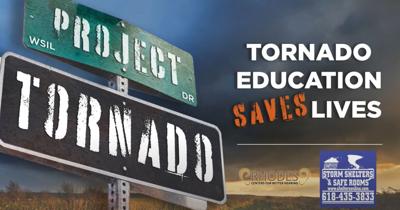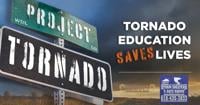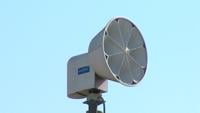As communities across Southern Illinois, Western Kentucky, Southeast Missouri, and Northwest Tennessee brace for another tornado season, the connection between our changing climate and the intensity of these storms becomes increasingly important to understand. As part of WSIL-TV鈥檚 PROJECT TORNADO program, StormTrack 3 Chief Meteorologist Jacie Brianne interviewed two leading experts to dig deeper into the connection between climate change and severe weather in our region.
- Dr. Justin Schoof, Director of The School of Earth Systems and Sustainability and Professor, Geography and Environmental Resources at Southern Illinois University is a renowned expert on climate change and a partner in WSIL鈥檚 Building A Better Community Initiative.
- Dr. Greg Postel is the Hurricane and Storm Specialist at The Weather Channel, WSIL鈥檚 weather and climate change partner. The Weather Channel and WSIL are both part of Allen Media Group, a Global Media, Content & Technology company.
The Elusive Climate-Tornado Link
Despite the advancement of meteorological science, establishing a direct correlation between climate change and the frequency of tornadoes has been a complex endeavor. Dr. Schoof points out the inherent difficulties in attributing single weather events, like tornadoes, directly to climate change. He likens the process to altering the odds in a game of dice 鈥� while climate change may increase the likelihood of extreme weather events, it doesn't guarantee them. "Think of double sixes as being what you would roll to get a (tornado) event. Maybe climate change has changed one of the dice, so it has two sixes...it increases the probability that you would roll double sixes and get that extreme (event).," explains Dr. Schoof.
As Dr. Schoof unpacks the nuances of climate influence, he stresses the subtlety of its role. Rather than creating entirely new weather events, climate change skews the frequency and severity of the events we are already familiar with. 鈥淚t's much harder for us to say when a tornadic event occurs, that this was or was not related to climate change. Whereas with heat waves, we know very solidly that climate change is making them worse.鈥�
Explore the comprehensive severe weather operations at NWS Paducah, highlighting the critical roles in forecasting, emergency response, and damage assessment that contribute to community safety and resilience.
El Nino鈥檚 Local Impact Unveiled
With the general increasing of odds for tornadoes and other severe weather based on global warming, it鈥檚 important to note another major climate factor that has been directly tied to 2023鈥檚 status of 鈥淗ottest Year on Record鈥�: El Nino and La Nina. This phenomenon of sea surface temperatures in the Pacific Ocean has a big impact on our region, according to Dr. Postel: 鈥渨hen we have either a transition to La Nina or a full-fledged La Nina event, we start to see the Jetstream take shape over the United States, which brings in a southwest flow aloft, bringing in moist and warm and unstable air from the Gulf of Mexico, leading to more severe weather typically than in El Nino.鈥�
The latest transition between La Nina and El Nino at the beginning of 2023 was unusual, according to Dr. Schoof, temperatures in the oceans inside and outside the tropics were unable to cool like normal. Will this spike of global temperatures on an already rising trend line cause severe weather to change for people in our region? Dr. Postel describes how it could happen: 鈥漈he broadening of the traditional Tornado Alley; it's not just a geographical shift; it's a temporal one鈥ith the tornado season starting earlier and ending later. We're witnessing an expansion eastward across the Deep South," he states, pinpointing areas in Mississippi, Alabama, and Tennessee now facing increased risks. Those risks now extend into seasons and months that are unusual to see tornadic activity: 鈥淲e are seeing tornado season really go a little bit earlier across parts of the south during winter and extend later on into the season as well.鈥�
The Science of Prediction
As an expert on severe storms at The Weather Channel, Dr. Postel has been on the air for a remarkable amount of tornadic events across the country. He says that the science of tornado prediction is still evolving: 鈥渨e have a pretty good grasp about the ingredients atmospherically and a bigger picture of what causes severe weather and pretty good idea of how to predict those larger scale ingredients. The problem is we still don't know which thunderstorms, which supercell thunderstorms, are going to produce tornadoes and which ones just don't have a chance to do that.鈥�
He, and other atmospheric scientists are still working to refine and improve their prediction methodology: 鈥淪cientists are working very hard on really understanding the ingredients that go into making a tornado from a severe thunderstorm that you might think produce a tornado that perhaps otherwise doesn't. All those will be sorted out in the coming years as scientists work on these problems.鈥�
Preparing for the Unpredictable
As we witness the expansion of Tornado Alley and an elongated tornado season, Dr. Postel's encourages a reevaluation of our readiness strategies. "it really boils down to whether or not the audience or the people can hear these warnings and just happen to be paying attention. That's one of the most dangerous and insidious things about severe weather, is knowing how to react to those warnings and making sure you're able to get them on any given day.鈥�
For any broadcast meteorologist, from the hundreds of professionals working at The Weather Channel watching severe storms develop from coast to coast to the team of broadcast meteorologists at WSIL, it鈥檚 the unexpected storm that viewers aren鈥檛 prepared for that cause the most concern. As Dr. Postel says 鈥測ou may be going about your daily routine and not have any clue that severe weather is coming. And the only way to know is if you happen to be tuning in. Those are the days and those are the instances that worry me the most. When we have a deadly severe weather event unfolding and people just are not aware of it coming.鈥�
As our understanding of climate's interplay with tornadoes deepens, so does the importance of readiness for such unpredictable events. With insights from experts like Dr. Justin Schoof and Dr. Greg Postel, we recognize the need for increased vigilance. WSIL-TV, alongside its weather partner The Weather Channel, reaffirms its commitment to keeping you informed and prepared. We urge our community to stay weather aware, not only through traditional means like NOAA Weather Radios but also through our readily accessible digital platforms. Download the StormTrack 3 mobile app for immediate lightning alerts and timely weather warnings, ensuring that no severe weather event catches you off guard. Stay tuned, stay safe, and stay ahead of the storm with 九游体育 3.





